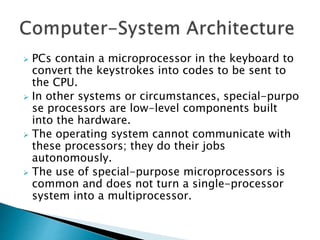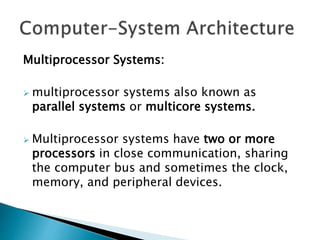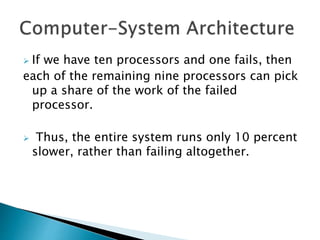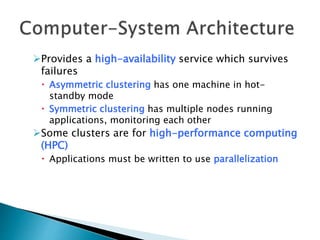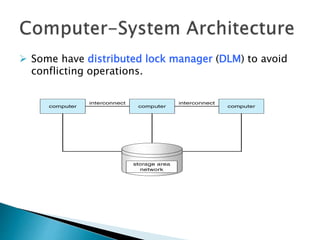Computer system architecture
- 2. Computer system can be organized in a number of can categorize roughly according to the number of general-purpose processors used. How a modern computer system works.
- 3. The general-purpose processors are categorized as follows. 1)Single-Processor Systems. 2)Multiprocessor Systems. 3) Clustered Systems.
- 4. Single-Processor Systems: Most computer systems used a single processor. On a single processor system, there is one main CPU capable of executing a general- purpose instruction set,including instructions from user processes.
- 5. Single-Processor Systems: Almost all single processor systems have other special-purpose processors as well. They come in the form of device-specific processors, such as disk, keyboard, and graphics controllers. on mainframes, they may come in the form of more general-purpose processors, such as I/O processors that move data rapidly among the components of the system
- 6. All of these special-purpose processors run a limited instruction set and do not run user processes. They are managed by the operating system, in that the operating systems ends them information about their next task and monitors their status.
- 7. For example, a disk-controller microprocessor receives a sequence of requests fromthemain CPU and implements its own disk queue and scheduling algorithm. This arrangement relieves the main CPU of the overhead of disk scheduling.
- 8. PCs contain a microprocessor in the keyboard to convert the keystrokes into codes to be sent to the CPU. In other systems or circumstances, special-purpo se processors are low-level components built into the hardware. The operating system cannot communicate with these processors; they do their jobs autonomously. The use of special-purpose microprocessors is common and does not turn a single-processor system into a multiprocessor.
- 9. Multiprocessor Systems: The multiple-processor systems in use today are of two types. 1. Asymmetric multiprocessing. 2. Symmetric multiprocessing. Asymmetric multiprocessing: in which each processor is assigned a specific task.
- 10. Symmetric multiprocessing (SMP): The most common systems use symmetric multiprocessing (SMP), in which each processor performs all tasks within the operating system.
- 11. Multiprocessor Systems: multiprocessor systems also known as parallel systems or multicore systems. Multiprocessor systems have two or more processors in close communication, sharing the computer bus and sometimes the clock, memory, and peripheral devices.
- 12. Multiprocessor systems first appeared prominently appeared in servers and have since migrated to desktop and laptop systems. Recently, multiple processors have appeared on mobile devices such as smart phones and tablet computers.
- 13. Multiprocessor systems have three main advantages: 1)Increased throughput. 2)Economy of scale. 3)Increased reliability.
- 14. 1.Increased throughput. By increasing the number of processors, we expect to get more work done in less time. The speed-up ratio with N processors is not N, however; rather, it is less than N.
- 15. Economy of scale. Multiprocessor systems can cost less than equivalent multiple single-processor systems, because they can share peripherals, mass storage, and power supplies. Increased reliability. If functions can be distributed properly among several processors,thenthe failure of one processor will not halt thesystem, only slow it down.
- 16. If we have ten processors and one fails, then each of the remaining nine processors can pick up a share of the work of the failed processor. Thus, the entire system runs only 10 percent slower, rather than failing altogether.
- 17. Clustered Systems: Another type of multiprocessor system is a clustered system, which gathers together multiple CPUs. Like multiprocessor systems, but multiple systems working together. Usually sharing storage via a storage-area network (SAN)
- 18. Provides a high-availability service which survives failures Asymmetric clustering has one machine in hot- standby mode Symmetric clustering has multiple nodes running applications, monitoring each other Some clusters are for high-performance computing (HPC) Applications must be written to use parallelization
- 19. Some have distributed lock manager (DLM) to avoid conflicting operations.








